Olavinlinna
Olavinlinna (Swedish: Olofsborg; literally Olaf's Castle) is a 15th-century three-tower castle located in Savonlinna, Finland. It is built on an island in the Kyrönsalmi strait that connects the lakes Haukivesi and Pihlajavesi. It is the northernmost medieval stone fortress still standing.[1]
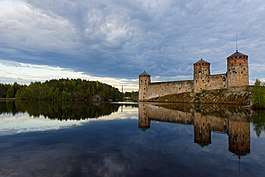
The castle forms a spectacular stage for the Savonlinna Opera Festival, held annually in the summer since 1912.[2]
History
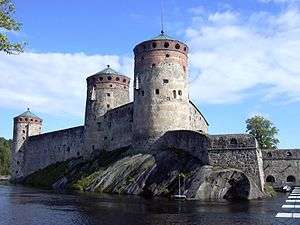
The fortress was founded by Erik Axelsson Tott in 1475 under the name Sankt Olofsborg in an effort to profit from the political turmoil following Ivan III's conquest of the Novgorod Republic. It was sited in Savonia so as to lay claim to the Russian side of the border established by the Treaty of Nöteborg.[3][4][5][6]
One of Tott's letters from 1477 includes a passing mention of foreign builders invited to Olofsborg, probably from Reval, where the city fortifications were being extended. It was the first Swedish castle provided with a set of thickset circular towers that could withstand cannon fire. It is not by accident that a network of lakes and waterways forms the setting for the castle, for these would seriously impede a prospective Russian offensive.
The three-towered keep was completed in 1485, and the construction of the outer curtain walls with two towers was initiated immediately. They were completed in 1495. The castle is roughly a truncated rhomboid with keep on the western side of the island and the curtain walls and outer bailey to east. One of the towers of the keep, St. Erik's Tower, has a bad foundation and has since collapsed. One of the towers of Bailey, the Thick Tower, exploded in the 18th century. A bastion has been built on its place. The castle was converted into a Vaubanesque fort in the late 18th century with bastions.[3]
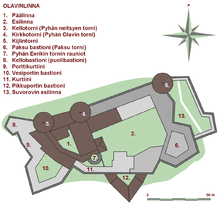
- Keep
- Outer Bailey
- Bell Tower (St. Virgin's Tower)
- Church Tower (St. Olof's Tower)
- Kijl's Tower
- Thick Bastion (on place of Thick Tower)
- Ruins of the collapsed St Erik's Tower
- Bell Bastion (semi-bastion)
- Gateway Curtain
- Watergate Curtain
- Curtain wall
- Smallgate Bastion
- Suvorov's Bailey
Warfare
Olofsborg withstood several sieges by the Russians during the First and Second Russian-Swedish wars. A brisk trade developed under the umbrella of the castle towards the end of the 16th century, giving birth to the town of Savonlinna, which was chartered in 1639.[3]
While the castle was never captured by force, its garrison agreed to terms of surrender twice; first to invading Russians on 28 July 1714 and the second time on 8 August 1743, with the latter conflict's peace treaty in form of the Treaty of Åbo leading to the castle and the entire region being seceded to Empress Elizabeth of Russia.[3] During the Russian era Alexander Suvorov personally inspected rearmament of the fortress.[7]
Several devastating fires destroyed much of the castle's decor in the 19th century, all of its original furnishings were destroyed.[8]
Tourism
The castle hosts several small exhibitions, including the Castle Museum which displays artifacts found in the castle or related to it, and the Orthodox Museum which displays icons and other religious artifacts both from Finland and Russia.
Olavinlinna is the initial model for Kropow Castle in the bande dessinée King Ottokar's Sceptre, an album in the series of Adventures of Tintin created by Hergé.[9]
Gallery
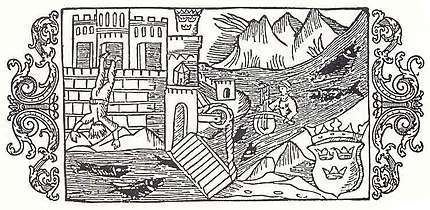 Olofsborg in Olaus Magnus' Historia de gentibus septentrionalibus, 1555
Olofsborg in Olaus Magnus' Historia de gentibus septentrionalibus, 1555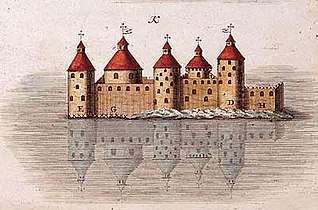 Olavinlinna the way it looked in 1690s before one of the towers was demolished, chalcography from 1762
Olavinlinna the way it looked in 1690s before one of the towers was demolished, chalcography from 1762 Lithography by Pehr Kruskopf, 1847
Lithography by Pehr Kruskopf, 1847 A View over the Castle Olavinlinna, Victoria Åberg, 1864
A View over the Castle Olavinlinna, Victoria Åberg, 1864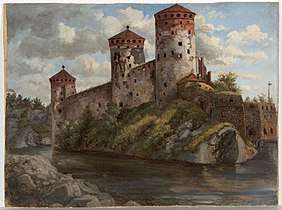 Olavinlinna by Victoria Åberg, unknown date
Olavinlinna by Victoria Åberg, unknown date Painting of the castle in 1870 by Oscar Kleineh, before restoration
Painting of the castle in 1870 by Oscar Kleineh, before restoration Sketch by Hjalmar Munsterhjelm, 1873
Sketch by Hjalmar Munsterhjelm, 1873.jpg) During winter by Hjalmar Munsterhjelm
During winter by Hjalmar Munsterhjelm Olavinlinna, Hjalmar Munsterhjelm, 1875
Olavinlinna, Hjalmar Munsterhjelm, 1875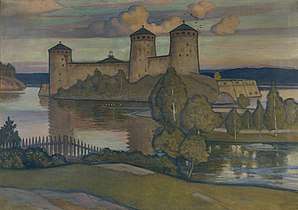 Olavinlinna, Väinö Blomstedt, 1900
Olavinlinna, Väinö Blomstedt, 1900
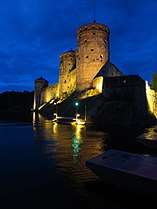 Lit in the night
Lit in the night Interior
Interior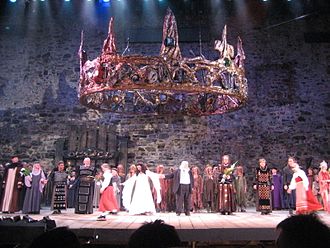 Macbeth applause at Savonlinna Opera Festival in 2007
Macbeth applause at Savonlinna Opera Festival in 2007 Savonlinna Opera in 2017
Savonlinna Opera in 2017_12.jpg) Russian president Vladimir Putin as a guest of Finnish president Sauli Niinistö at Savonlinna Opera, 2017
Russian president Vladimir Putin as a guest of Finnish president Sauli Niinistö at Savonlinna Opera, 2017
References
- "Savonlinnan vaiheita". Savonlinna. Retrieved 29 June 2020.
- "Olavinlinna". Savonlinnan Oopperajuhlat. Retrieved 29 June 2020.
- "Olavinlinna Castle History". Kansallismuseo. Retrieved 29 June 2020.
- "Olavinlinna, Kyrön- ja Haapasalmen kulttuurimaisema". Valtakunnallisesti merkittävät rakennetut kulttuuriympäristöt RKY. Retrieved 29 June 2020.
- "Olavinlinna, Savonlinna". Museovirasto Restauroi. Retrieved 29 June 2020.
- Koskela, Hannu (20 July 2017). "Vuonna 1475 Ruotsin Kruunun mahtimies Eerik Akselinpoika Tott perusti linnan Savoon turvaamaan rajaa itäistä vihollista vastaan. Nyt se on oopperan tyylikäs tyyssija". Apu. Retrieved 29 June 2020.
- "Olavinlinnan hurjat tarinat: Vanki karkasi pellavaköyden avulla". Studio55. 25 April 2012. Retrieved 29 June 2020.
- Olavinlinna (Finland) Vacation Travel Video Guide, retrieved 2019-11-02
- Severi Nygård: Tintti Suomessa. Helsingin Sanomat, Kuukausiliite, October 2008.
External links
| Wikimedia Commons has media related to: |